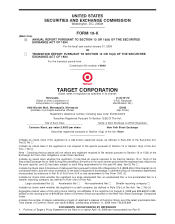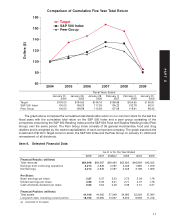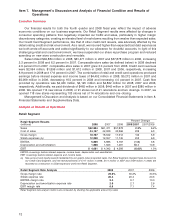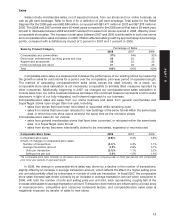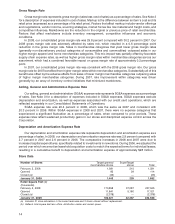Target 2008 Annual Report Download - page 25
Download and view the complete annual report
Please find page 25 of the 2008 Target annual report below. You can navigate through the pages in the report by either clicking on the pages listed below, or by using the keyword search tool below to find specific information within the annual report.
If we do not continually attract, train and retain qualified employees, our results of operations could be
adversely affected.
Our business is dependent on our ability to attract, train and retain a large and growing number of
qualified team members. Many of those team members are in entry-level or part-time positions with historically
high turnover rates. Our ability to meet our labor needs while controlling our costs is subject to external factors
such as unemployment levels, health care costs and changing demographics. If we are unable to attract and
retain adequate numbers of qualified team members, our operations, guest service levels and support
functions could suffer, and we could experience delays in opening new stores. Those factors, together with
increased wage and benefit costs, could adversely affect our results of operations.
Inability to build new stores in suitable locations could slow our growth, and difficulty in building new
stores could increase our costs and capital requirements.
Our future growth is dependent, in part, on our ability to build new stores and expand existing stores in a
manner that achieves appropriate returns on our capital investment. We compete with other retailers and
businesses for suitable locations for our stores. In addition, for many sites we are dependent on a third party
developer’s ability to acquire land, obtain financing and secure the necessary zoning changes and permits for
a larger project, of which our store may be one component. Turmoil in the financial markets has made it
difficult for third party developers to obtain financing for new projects. Local land use and other regulations
applicable to the types of stores we desire to construct may impact our ability to find suitable locations and
also influence the cost of constructing and expanding our stores. A significant portion of our expected new
store development activity is planned to occur within fully developed markets, which is generally a more
time-consuming and expensive undertaking than developments in undeveloped suburban and ex-urban
markets. Delays in new store openings could have an adverse effect on our sales growth, and increased costs
associated with new stores and store expansions could adversely affect our results of operations.
Interruptions in our supply chain could adversely affect our results.
We are dependent on our vendors to supply merchandise in a timely and efficient manner. If a vendor fails
to deliver on its commitments, whether due to financial difficulties or other reasons, we could experience
merchandise shortages that could lead to lost sales. In addition, a large portion of our merchandise is
sourced, directly or indirectly, from outside the United States, with China as our single largest source. Political
or financial instability, trade restrictions, tariffs, currency exchange rates, the outbreak of pandemics, labor
unrest, transport capacity and costs, port security or other events that could slow port activities and impact
foreign trade are beyond our control and could disrupt our supply of merchandise and adversely affect our
results of operations.
Product safety concerns could adversely affect our sales and results of operations.
If our merchandise offerings, including food, drug and children’s products, do not meet applicable safety
standards or our guests’ expectations regarding safety, we could experience lost sales, experience increased
costs and be exposed to legal and reputational risk. All of our vendors must comply with applicable product
safety laws, and we are dependent on them to ensure that the products we buy comply with all safety
standards. Events that give rise to actual, potential or perceived product safety concerns, including food or
drug contamination, could expose us to government enforcement action or private litigation and result in
costly product recalls and other liabilities. In addition, negative guest perceptions regarding the safety of the
products we sell could cause our guests to seek alternative sources for their needs, resulting in lost sales. In
those circumstances, it may be difficult and costly for us to regain the confidence of our guests.
If we fail to protect the security of personal information about our guests, we could be subject to costly
government enforcement actions or private litigation and our reputation could suffer.
The nature of our business involves the receipt and storage of personal information about our guests. If
we experience a data security breach, we could be exposed to government enforcement actions and private
litigation. In addition, our guests could lose confidence in our ability to protect their personal information,
which could cause them to discontinue usage of our credit card products, decline to use our pharmacy
5
PART I






